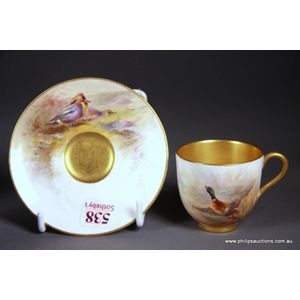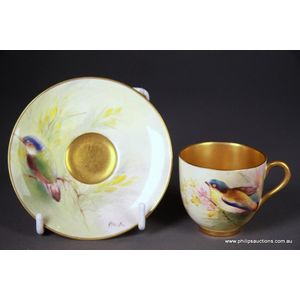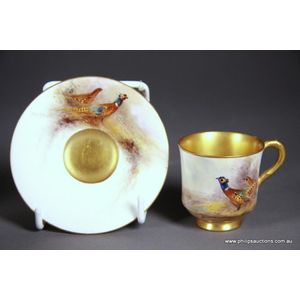Royal Worcester Shakespeare Birthplace Coffee Set
You must be a subscriber, and be logged in to view price and dealer details.
Subscribe Now to view actual auction price for this item
When you subscribe, you have the option of setting the currency in which to display prices to $Au, $US, $NZ or Stg.
- Coffee Can - A coffee can is a cup for holding coffee, but of a cylindrical shape rather than the waisted shape of traditional cups. They were in use at the end of the 18th century and in the early 19th century.
- Ivory - Ivory is a hard white material that comes from the tusks of elephants, mammoth, walrus and boar, or from the teeth of hippopotamus and whales. The ivory from the African elephant is the most prized source of ivory. Although the mammoth is extinct, tusks are still being unearthed in Russia and offered for sale.
Ivory has been used since the earliest times as a material for sculpture of small items, both in Europe and the east, principally China and Japan.
In Asia ivory has been carved for netsuke, seals, okimono, card cases, fan supports, animals and other figures and even as carved tusks.
In the last 200 years in Europe ivory has been used to carve figures, for elaborate tankards, snuff boxes, cane handles, embroidery and sewing accessories, in jewellery and as inlay on furniture. Its more practical uses include being used for billiard balls, buttons, and a veneers on the top of piano keys.
The use and trade of elephant ivory have become controversial because they have contributed to Due to the decline in elephant populations because of the trade in ivory, the Asian elephant was placed on Appendix One of the Convention on International Trade in Endangered Species (CITES), in 1975, and in January 1990, the African elephant was similarly listed. Under Appendix One, international trade in Asian or African elephant ivory between member countries is forbidden. Unlike trade in elephant tusks, trade in mammoth tusks is legal.
Since the invention of plastics, there have been many attempts to create an artificial ivory
This item has been included into following indexes:
Visually similar items

A signed Royal Worcester demitasse cup and saucer, 1928 (saucer) and probably 1931 (cup), both decorated by Jas Stinton. The tapering cup with a petite foot rim painted with a flying wood duck in a naturalistic setting, the saucer with a pair of ducks besi

A Royal Worcester bird cup and saucer, 1929, with signature of R. Austin, Delightfully painted with a blue headed bird with green feathers perched on a branch amongst yellow flowers upon a lemon cream ground, with a burnished gilt interior and trims; with

A signed Royal Worcester demitasse cup and saucer, 1919, with decoration by Jas Stinton. The petite cup of slightly flaring profile with a small foot rim, gilded to the interior and decorated with a scene of pheasants in a naturalistic setting, the saucer

Royal Worcester handpainted demitasse circa 1908, as inspected
